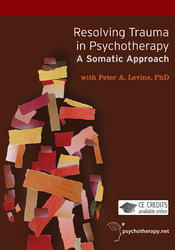 Mental and physical wellness are interwoven. As such, there is a need for evidence-based, body-oriented approaches to treating mental health issues such as trauma. Through the intensive study of the psychobiology of trauma, Dr. Peter Levine has developed a body-oriented approach called Somatic Experiencing (SE) as a framework for assessing and treating trauma. In this video (running 3 hours and 20 minutes), Levine provides a basic introduction to the conceptual framework and clinical tools used in SE.
Mental and physical wellness are interwoven. As such, there is a need for evidence-based, body-oriented approaches to treating mental health issues such as trauma. Through the intensive study of the psychobiology of trauma, Dr. Peter Levine has developed a body-oriented approach called Somatic Experiencing (SE) as a framework for assessing and treating trauma. In this video (running 3 hours and 20 minutes), Levine provides a basic introduction to the conceptual framework and clinical tools used in SE.
Levine uses a variety of instructional approaches to help viewers gain a basic understanding of the role of the body and body-oriented interventions in addressing trauma. At several points in the film Levine is joined by Laura Regalbuto, who interviews him by posing questions such as, “What is trauma and what happens to the nervous system of a person who experiences trauma?” Levine clearly articulates the conceptual foundation for SE, including a description of Dr. Stephen Porge’s polyvagal theory. Levine also describes the nine building blocks of SE. Throughout the video, segments from the case of Ray, a progression of five SE sessions facilitated by Levine, are presented to illustrate these concepts and demonstrate how positive change can occur through the application of SE.
Central to the SE approach is the assertion that trauma occurs when we are overwhelmed by an experience, or experiences, such that we are unable to physiologically and psychologically process the event(s). This state of being overwhelmed is thought to result in an inability to restore our equilibrium due to the sustained physiological responses associated with the stress response system. Levine argues that these physiological responses must be addressed in order for traditional cognitive, behavioral and affective approaches to be effective. Thus, he developed SE to do just that.
Though Levine asserts that SE can be used to address a host of traumatic experiences including accidents, abuse, medical issues, sexual assault and natural disasters, the primary focus of the video is on a war-related trauma as presented through the case of Ray. Ray experienced trauma when he was involved in an explosion during military deployment. Several months after the trauma, in addition to symptoms associated with traumatic brain injury and post-traumatic stress disorder (PTSD), Ray exhibited medically unexplained physical spasms resembling symptoms of Tourette syndrome. Over the course of five sessions, Levine uses SE techniques to help Ray build body awareness, learn to access the relaxation response, and begin to process his affective experiences. Ray reports decreases in PTSD symptoms as well as a reduction in physical spasms. Viewing the progression of Ray’s treatment with Levine’s accompanying commentary clearly illustrates how SE is used to address Ray’s concerns.
Consequently, the potential benefits of viewing this video for counseling professionals who treat trauma are several-fold. Broadly speaking, in order to effectively help clients heal from trauma, it is critical that counselors understand the psychobiology of trauma and have the clinical tools to address both mind and body. Viewing this video is a step toward this end. The case presented is a powerful demonstration of SE. Of course, further training and exposure to a variety of cases is necessary in order to truly understand SE and how it can be applied to treat other types of trauma and symptomology.
Like many introductory videos, for most counselors (particularly those who have limited previous knowledge of body-oriented approaches) this video will likely raise more questions than answers. In fact, there are several points in the video where Levine cautions that further training is needed to utilize the interventions that he demonstrates. For instance, Levine frequently uses physical touch as an intervention. At minimum, to utilize these touch-based approaches ethically and effectively, counseling professionals must complete advanced training in bodywork and clearly address the use of physical touch in the informed consent process.
Viewing this video will give counselors a basic understanding of SE. For those interested in integrating SE into their practice, the complete SE training is over 200 contact hours and is typically completed through a series of eight trainings over the course of 3 years. Further information is available at http://www.traumahealing.org.
Reviewed by: Jamie E. Crockett, NCC, Wake Forest University
Psychotherapy.net (Producer), & Yalom, M.-H. (Director). (2015). Resolving trauma in psychotherapy: A somatic approach with Peter A. Levine, Ph.D. [Streaming video]. Retrieved from www.psychotherapy.net
Available in streaming format and as part of video subscription at www.psychotherapy.net/subscriptions.
The Professional Counselor
